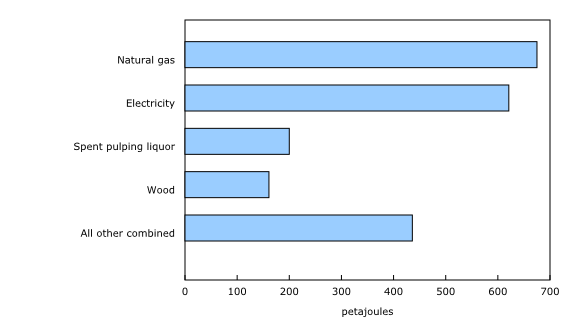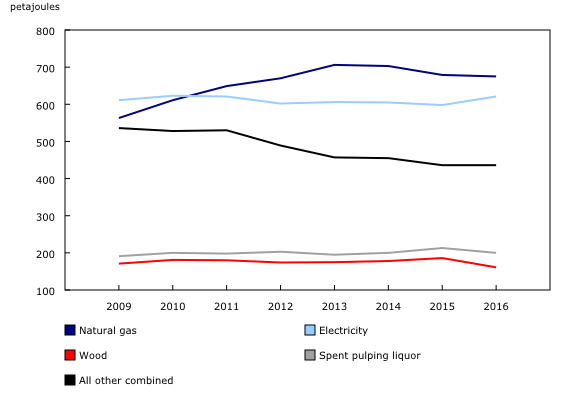Energy consumption by the manufacturing sector, 2016
Archived Content
Information identified as archived is provided for reference, research or recordkeeping purposes. It is not subject to the Government of Canada Web Standards and has not been altered or updated since it was archived. Please "contact us" to request a format other than those available.
Released: 2017-10-23
The manufacturing sector consumed 2 093 petajoules of energy as part of the production process in 2016, down 0.9% from 2015.
Highest sources of energy consumed
Natural gas (32.3%) was the largest source of energy consumed in the production process in 2016, followed by electricity (29.7%), spent pulping liquor (9.6%) and wood (7.7%).
Other energy sources combined accounted for the remaining 20.8% of the total energy consumed.
Growth in natural gas consumption outpaces electricity
Prior to 2011, electricity was the largest source of energy consumed by the manufacturing industry. Natural gas became the most consumed energy in 2011 and has since grown at a faster pace than electricity. From 2009 to 2016, natural gas consumption rose by 19.9% while electricity consumption grew by 1.6%.
Over this same period, the consumption of spent pulping liquor grew by 4.9%, while the consumption of wood use (-5.9%) and all other fuels combined (-18.7%) declined.
Top consumers of energy in the manufacturing sector
In 2016, the top consumers of energy were paper (25.1%), primary metal (22.5%), petroleum and coal products (14.0%) and chemical (14.0%) manufacturers, which combined accounted for 75.7% of the total energy consumed.
Natural gas was primarily consumed by chemical (27.8%), primary metal (16.5%), paper (11.9%) and petroleum and coal products (10.4%) manufacturers, accounting for 66.7% of the manufacturing industries.
The largest consumers of electricity were the primary metal (38.0%), paper (22.1%), chemical (12.4%) and wood product (3.9%) manufacturers, accounting for 76.4% of the total electricity consumed in the production process.
Spent pulping liquor was only consumed by the paper manufacturing industry, while the largest consumers of wood and wood waste were the paper (54.8%) and wood products (42.8%) manufacturing industries.

In celebration of the country's 150th birthday, Statistics Canada is presenting snapshots from our rich statistical history.
During the post-war period, there was considerable reliance on fuel oil and other petroleum products by Canadian manufacturers. In 1953, the highest expenditure on energy was made by the paper products industry, followed by non-ferrous metal products; iron and steel products; foods and beverages; products of petroleum and coal; and the non-metallic mineral products industries.
In 1996, manufacturing industries consumed 2 493 petajoules of energy with paper; primary metals; petroleum and coal products; chemical; and wood products manufacturing industries, accounting for 83.2% of the total. Natural gas and electricity accounted for over half (57.3%) of the energy sources. In 2016, Canadian manufacturers used 2 093 petajoules of energy, down 16.0% from 1996. The same five industries cited in 1996 accounted for 81.7% of the consumption in 2016, with natural gas and electricity accounting for 61.9% of the energy sources.
Note to readers
The Industrial Consumption of Energy Survey, sponsored by Natural Resources Canada and Environment and Climate Change Canada, estimates energy consumed by type of fuel in Canadian manufacturing.
The target population consists of Canadian establishments classified by the North American Industry Classification System (NAICS) to manufacturing sectors 31, 32 and 33.
The 2016 survey estimates are based on a sample of 4,720 establishments, which represents a weighted response rate of 89.5%.
A joule is a derived measure of energy or work. One gigajoule is equal to one billion (109) joules and six gigajoules are roughly equivalent to the amount of potential energy in one US standard barrel of oil when consumed. One petajoule is equal to 1015 joules.
Other energy sources include butane; coal; coal coke; coke oven gas; heavy fuel oil; middle distillates; petroleum coke and coke from catalytic cracking catalyst; propane; refinery fuel gas; and purchased steam.
Electricity consists of both purchased and self-generated electricity.
Totals and percentages may not add up due to rounding.
Data for 2015 have been finalized, while data for 2016 are subject to revision.
Contact information
For more information, or to enquire about the concepts, methods or data quality of this release, contact us (toll-free 1-800-263-1136; 514-283-8300; STATCAN.infostats-infostats.STATCAN@canada.ca) or Media Relations (613-951-4636; STATCAN.mediahotline-ligneinfomedias.STATCAN@canada.ca).
- Date modified:



